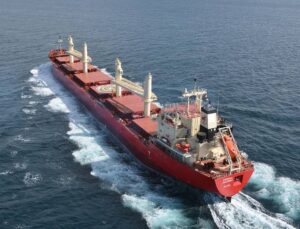Packing of Break Bulk Cargoes
Break bulk cargoes of grains, coffee, cement, etc. may be packed in bags of a standard size such as 25 or 50 KG bags. In such cases, to prevent damage to the goods caused by seawater or moisture, the bags are made of special water-proof and weather-proof materials.

They must also carry clear written and visual instructions on handling to prevent damage caused by hooks and other such lifting or carrying equipment. Bags are normally kept away from the sides of the ship or bulk heads to prevent damage caused by seawater. They may also be covered using water-proof sheets.
Crates and Corrugated Boxes
Crates help to transport certain types of goods as break bulk. They may be made of wood or plastic. Crates help to stack the cargo while protecting what is inside. Goods that are commonly transported in crates or corrugated boxes as break bulk are machines and machine parts, fruits, etc.
Corrugated boxes are usually made of cardboard or fiberboard but are quite sturdy. There are different grades of such boxes that are resistant to moisture and other inclement weather conditions. Care should be exercised while stacking corrugated boxes and not exceeding the prescribed limit for stacking.
Mostly, crates and corrugated boxes are palletized for transport to make the loads stable and for ease of loading.
Barrels and Drums
Barrels and Drums are used in the transport of liquid cargoes such as oils and associated products. Whiskies and certain other alcoholic drinks are also sometimes transported in barrels or wooden casks. Drums are made of metal and can be stored upright or on their sides.
When stored on their sides, special heavy-duty wedges are used to prevent them from rolling. Packing material is sometimes placed between barrels to prevent them from rubbing against each other.
Pallets
Pallets are either made of wood or plastic and come in different sizes. The widely recognized ones are the standard pallet and the euro pallet. The former measures 48” X 40” while the latter is 47.24” X 39.37”. Goods can be stacked and secured on such pallets for ease of loading and storage onboard a ship.
Read Also: IMO Launches e-Learning Platform
Loading of Break Bulk Cargo
Break bulk cargo is usually delivered to the quay by trucks or cargo trains and loaded directly onto a ship. In some cases, it is brought and stored in the port warehouse before a ship’s ETA (Estimated Time of Arrival).
When the ship arrives and it is ready for loading, these goods are moved to the ship. This is usually done when there is a large number of goods for loading and it has to be brought in several batches. Port warehouse storage is opted by shippers when goods have to be brought in from different locations.
The ship’s holds or the storage areas have to be washed, cleaned, and dried before receiving a break bulk load.
Unloading of Break Bulk Cargo
When a ship arrives at the port with its load of break bulk cargo, it is offloaded directly onto trucks or train wagons and taken to its destination. In certain cases, it may be offloaded and stored at the port warehouse from where it is taken by the consignee at a later point in time. This is often done when the consignee does not have a warehouse to store the goods.
Besides, port warehouse storage charges are usually lower than those of private warehouses outside the port area. Once unloading is complete, a ship’s stowage area is cleaned of all traces of the cargo that it had carried, washed, and dried before it is ready to receive the next load.
*Concluded
Kindly like us on Facebook















